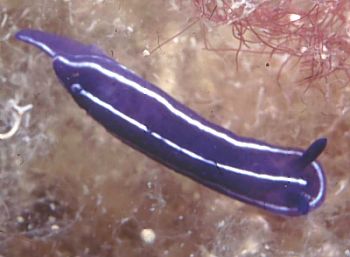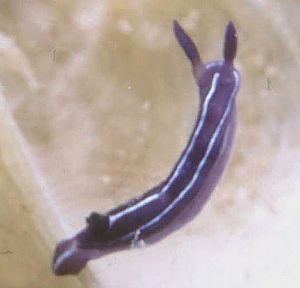Hypselodoris orsinii? from Turkey
September 28, 2001
From: Baki Yokes


Dear Bill,
I'm not sure whether these photos belong to Hypselodoris tricolor or Hypselodoris orsinii (H. coelestis according to Societa Italiana di Malacologia). Although they lack the yellow margin, they match with the description given in the Atlas of Mediterranean Nudibranchs for H. tricolor pp.75), since the margin can be white as well according to the decription given. When compared to the blue chromodorid in my other message, these specimens are thinner and smaller, and never exceed 2 cm in size. They are very common in North Aegean Sea and can be seen at any depth, usually on black horny sponges Cacospongia sp.
Both photos were taken by me at Saros Bay Divesite, Canakkale, Turkey. Upper Photo: Depth: 12m; 2cm long; September 1999. Lower Photo: Depth: 8m; 1cm long; August 1999
Best wishes
Baki
bakiyokes@turk.net
Yokes, B., 2001 (Sep 28) Hypselodoris orsinii? from Turkey. [Message in] Sea Slug Forum. Australian Museum, Sydney. Available from http://www.seaslugforum.net/find/5339Dear Baki,
Thanks for these photos. I can understand your confusion with these 'blue chromodorids' which are still in the process of being sorted out. They represent a group of related species which have evolved to look very alike so that predators learn to leave this blue colour pattern alone. Predators avoid them because they store noxious chemicals in glands or sacs in their skin. Have a look at the Page on a group of red-spotted species in Australia which do the same thing.
So there are a number of problems to untangle. Firstly, we need to work out how many species there are and how to recognise them, preferably without having to dissect every individual to be sure! Secondly, we need to go through all the old literature and try and determine what all the old names for these species refer to. In some cases the descriptions consist of 2 or 3 lines of text saying little more than 'blue with yellow lines'. And thirdly we then need to try and untangle all the subsequent identifications and misidentifications of the names which have occurred in the last century.
Unfortunately many of the biological and ecological studies which have been published on these animals may be useless unless there is some way of checking and confirming the identifications of the animals they studied.
I am using the most recent revision of this group [Ortea, Valdés & García-Gómez, 1996 -see reference at top of page] but even that may not be the final story. In that your animal is identified as Hypselodoris orsinii and Cacospongia sp. is its reported food sponge. It is possible you have more than 2 of these blue species in your area. Apart from keeping an eye open for strange colour patterns, one valuable contribution would be to see if you can find blue chromodorids on other sponges, and where possible see if you can photograph them laying eggs. A closeup of the egg ribbon might provide a very useful piece of information.
Best wishes,
Bill Rudman
Related messages
-
Re: Feeding in Hypselodoris orsinii
From: Dominique Horst, October 15, 2008 -
Re: Hypselodoris orsinii from Croatia
From: Adam Petrusek, October 8, 2003 -
Hypselodoris orsinii from Croatia
From: Adam Petrusek, October 7, 2003 -
Hypselodoris coelestis from the Mediterranean
From: Nicolas, March 18, 2003 -
How to recognise Hypselodoris orsinii
From: Jean-Pierre Bielecki, June 29, 2002 -
Feeding in Hypselodoris orsinii
From: Jean-Pierre Bielecki, June 29, 2002 -
Re: Hyps. orsinii from French Mediterranean
From: Marina Poddubetskaia , June 26, 2002 -
Re: Hypselodoris orsinii from French Mediterranean
From: Alma Sánchez, June 25, 2002 -
Hypselodoris orsinii from French Mediterranean
From: Marina Poddubetskaia, June 24, 2002
